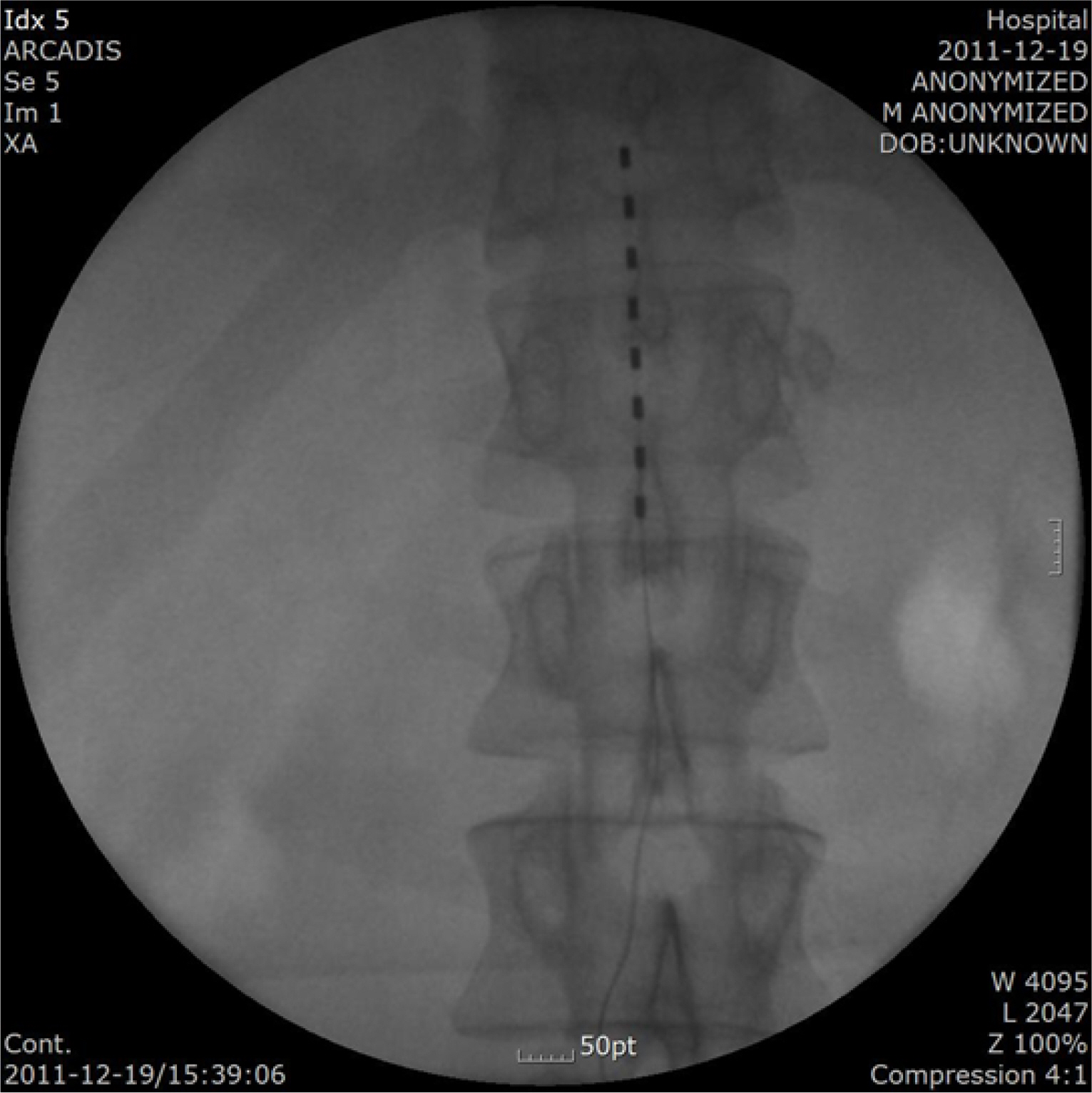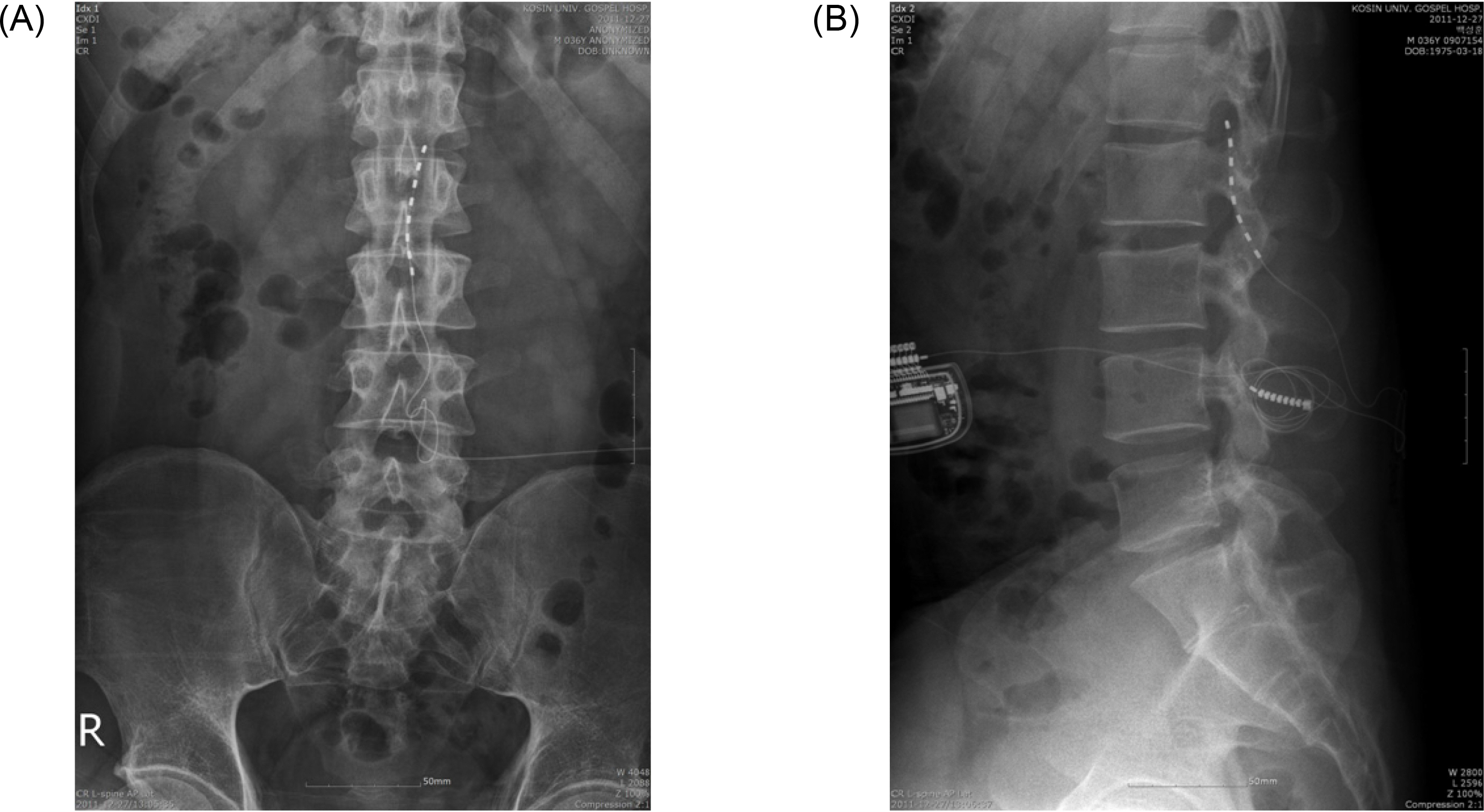Kosin Med J.
2014 Jun;29(1):69-73. 10.7180/kmj.2014.29.1.69.
A Case of Lead Migration Caused by Involuntary Movement in Implanted Spinal Cord Stimulation
- Affiliations
-
- 1Department of Anesthesiology and Pain Medicine, College of Medicine, Kosin University, Busan, Korea. uamyfriends@hanmail.net
- KMID: 1882442
- DOI: http://doi.org/10.7180/kmj.2014.29.1.69
Abstract
- Spinal cord stimulation (SCS) is a reliable clinical option for treatment of refractory chronic pain. It is known to be effective method for treating sympathetic pain, failed back surgery syndrome, and complex regional pain syndrome etc. The devices and implantation techniques for SCS are already highly developed and continuously improving, but there are some complications that can not be corrected easily. Lead migration is the most common complication after SCS. It can cause failure of SCS that can make discomfort to patients. Here we describe our experience of lead migration in implanted SCS which was inserted to a patient with complex regional pain syndrome patient.
Keyword
Figure
Reference
-
1. North RB, Wetzel FT. Spinal cord stimulation for chronic pain of spinal origin: a valuable longterm solution. Spine. 2002; 27:2584–91.2. Mekhail NA, Mathews M, Nageeb F, Guirguis M, Mekhail MN, Cheng J. Retrospective review of 707 cases of spinal cord stimulation: indications and complications. Pain Pract. 2011; 11:148–53.
Article3. North RB, Kidd DH, Zahurak M, James CS, Long DM. Spinal cord stimulation for chronic, intractable pain: experience over two decades. Neurosurgery. 1993; 32:384–94.4. Oakley JC, Prager JP. Spinal cord stimulation: mechanisms of action. Spine. 2002; 27:2574–83.5. Yoon JH, Moon DE, Lee CW, Ryu KH. Cervical spinal cord stimulation in a patient with complex regional pain syndrome in the upper extremity. Korean J Pain. 2004; 17:243–7.6. Patel S, Huang DL, Sagher O. Sympathetic mechanisms in cerebral blood flow alterations induced by spinal cord stimulation. J Neurosurg. 2003; 99:754–61.
Article7. Alo KM, Holsheimer J. New trends in neuromodulation for the management of neuropathic pain. Neurosurgery. 2002; 50:690–703.8. Nelson DV, Stacey BR. Interventional therapies in the management of complex regional pain syndrome. Clin J Pain. 2006; 22:438–42.
Article9. Cameron T. Safety and efficacy of spinal cord stimulation for the treatment of chronic pain: A 20-year literature review. J Neurosurg Spine. 2004; 100:254–67.
Article10. McGreevy K, Williams KA, Christo PJ. Cephalad lead migration following spinal cord stimulation implantation. Pain Physician. 2012; 15:79–87.11. Renard VM, North RB. Prevention of percutaneous electrode migration in spinal cord stimulation by a modification of the standard implantation technique. J Neurosurgery spine. 2006; 4:300–3.
Article12. Mironer YE, Brown C, Satterthwaite JR, Cohen M, Tonder LM, Grumman S. A new technique of "midline anchoring” in spinal cord stimulation dramatically reduces lead migration. Neuromodulation. 2004; 1:32–7.
Article13. Koo MS, Kim YC, Kim MH, Francis SN, Suh JH, Shin WY, et al. Lead breakage in implanted spinal cord stimulation systems. Korean J Anesthesiology. 2007; 54:229–31.14. Whitworth LA, Feler CA. C1-C2 sublaminar insertion of paddle leads for the management of chronic painful conditions of the upper extremity. Neuromodulation. 2003; 6:153–7.
Article
- Full Text Links
- Actions
-
Cited
- CITED
-
- Close
- Share
- Similar articles
-
- Cervical Spinal Cord Stimulation Using an 8 Electrode Lead in a Patient with Complex Regional Pain Syndrome Type I: A case report
- Spontaneous Lead Breakage in Implanted Spinal Cord Stimulation Systems
- Treatment of Tremor and Spasticity in Failed Back Surgery Syndrome with Spinal Cord Stimulation: A case report
- Lead Breakage in Implanted Spinal Cord Stimulation Systems: A case report
- Experience with Spinal Cord Stimulation for Relief of Causalgia on the Right Lower Extremity: A case report



